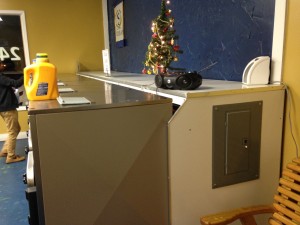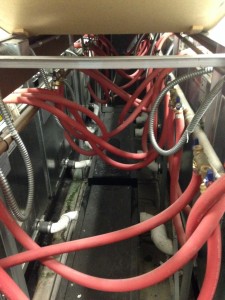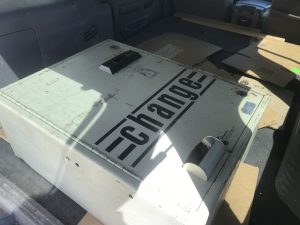Coin Laundry Bulkheads- Definition and Explanation
This is a term that many who have been in the Coin Laundry business for years talk about all of the time and we may forget that people that are new to the business are not familiar with all of the terminology.
Bulkheads
Lets start with a definition and go from there.
Bulkhead may refer to:
A structural safety device:
- Bulkhead (partition), a wall within the hull of a ship, vehicle, or container
- Torpedo bulkhead, a type of armor designed to keep a ship afloat even if the hull is struck by a shell or by a torpedo
- Bulkhead (barrier), a retaining wall used as a form of coastal management, akin to a seawall, or as a structural device such as a bulkhead partition
- Bulkhead door, an angled door covering the exterior stairwell of a basement
- Bulkhead flatcar, a type of rolling stock designed with sturdy end-walls to prevent loads from shifting past the ends of the car
- Rear pressure bulkhead, an airtight structural feature of an aircraft
Well that certainly cleared it up.
As with many words they have evolved from the original meaning and morphed into something else.
We can pull out part of the term that it means a wall. Previously I worked in the paint facility of an automotive manufacturing plant. A bulkhead there referred to a part of a wall or a steel plate where the paint lines connected from one side to the other. Usually through a row of fittings.
We are getting closer now.
In Laundromats the Bulkheads are the area behind the washers where the utilities are routed and connected.
The sizes vary depending on the size and type of the machines.

Older Laundromat normally had rows of Top Load washing machines. They backed up against a bulkhead that was run through the store. These tended to be short and narrow. Typically about the height of the back of the Top Load washer and about 12′ to 16′ across.
As machines got bigger these were sometimes modified to be taller the cover the back of the newer washers.
The contents of the bulkhead have not changed.
Power: This can be from 120 V to 240 V in most laundromats and could be single or 3 Phase. The connections are made directly in the back of the machine or through a standard plug and receptacle.


Hers are normally mounted on the ends of the bulkhead to provide easy access for Service Techs and customers should a problem come up. The older Top Loader bulkheads had the electrical panels mounted under the top cover.


Although the height of the bulkhead has increased the depth was not as there were no other washers on this side of the bulkhead. If washers were added the bulkhead would need to be increased to at least 30″ deep.

Water: Hot and cold. Piping sizes have increased from 1/2″ up to 2″ depending on the size and amount of washers connected to each bulkhead. Each washer will have a minimum of 1 Hot and 1 Cold connection. Some have additional connections for feeding the chemicals (soap) trays so the flow can be adjusted to prevent the soap tray from overflowing or spraying out the top. These can be connected with a Y connection after the valve or with a separate connection to the piping.
The main water pipes are sometimes referred to as Header pipes (Headers). Each connection will have a valve at the header.
The timers on most washing machines do not actually run until the washer fills with water to the preset level. Having the right sized piping and water flow will fill the washers fast and complete the wash in the shortest time possible.
Water flow is affected by each part of the system. Piping and hoses should be as large as possible (within reason of course). But don’t overlook the valves at the headers. Install a ball valve or similar type will provide a full flow of water as opposed to a Globe valve that has restriction built in.

The following diagrams help show this difference.



Another possible restriction is the hose size between the valve and the washer. Many installations now are completed with custom hoses made of 3/4″ ID (Interior Dimension) material. The ones for your home washer are not meant for a large capacity washer.


Drains: The water has to go somewhere and it’s all downhill from here. Top Load and small, soft mount front load washers have built-in pumps to push the water up and into a drain pipe. This type of setup is also used to prevent the water from running out of the washer. Larger washers have a gravity drain that is controlled by a drain valve below the drum that is opened and closed between cycles.
A washer with a drain valve is connected directly to the drain pipe and will probably be combined with the other washers to the building drain. The drain piping size and the slope is also important to handle the volume that will fill the pipe when the drain valve opens.
Many customers that are using multiple machines will start them all within seconds of each other so they all finish at the same time.
The drains can be connected together in a single pipe or connected to a steel drain trough. This trough works well as a place for coins and other items to settle and prevent the piping from being plugged. In some cases, the drain is an open trough under the bulkheads. This is only found in older stores as it leads to a humid and smelly laundromat.


This problem was covered here and Here
That is the basics of Laundromat Bulkheads. The size, shape, and material vary but they all have the same purpose.
When you are designing your laundromat or making upgrades make sure the bulkheads are big enough and deep enough to handle all of the utilities and the Service Tech that needs to get in there to work on the equipment. Most washer motors can only be removed from the back.
If you have any questions or comments please let me know.
Ken





